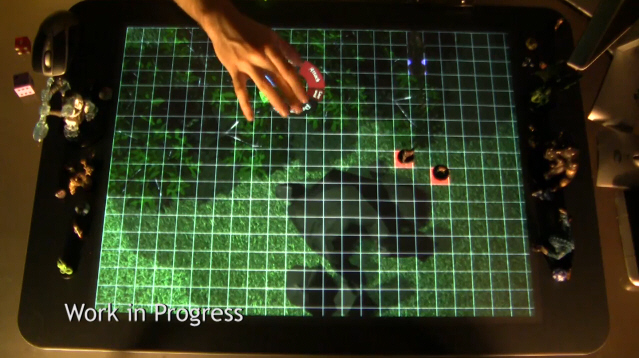CMU Team Creates D&D for Microsoft Surface
The Surfacescapes team at the Entertainment Technology Center at Carnegie Mellon University created Dungeons and Dragons (table-top style) for Microsoft Surface

The "Surfacescapes" team at the Entertainment Technology Center at Carnegie Mellon University has created a proof-of-concept demonstration using Microsoft's Surface technology and the tabletop version of Dungeons and Dragons. The 3:24 video shows how the idea works by using virtual dice, scalable maps, and physical miniatures.
The clip opens up with the players "registering" by placing a "control object" onto the surface that point to the player's actual position. This is followed by registering the player's actual miniature, and then allowing the player to choose a stored character. Once everyone is set up, the system moves into the "exposition" part of the game where the dungeon master can insert a slideshow or text that sets the scene for the overall story.
After the introduction, the world map loads and is panned and zoomed by using another control object. Once players chose an area to explore, the map zooms down to the actual battle map, or rather the playing field. The video showed a scenario taking place outside a stretch of woods, with the DM controlling a dire wolf and two players controlling their miniatures. The players roll a virtual 20-sided die to determine the initiative, or rather, which party gets to attack first.
According to the video, the DM plays the game on a separate PC, thereby allowing the game to encompass the entire Surface field for the players. From his PC, the DM moved the dire wolf while the Surface system visually moved the beast from the field over into the woods. In the next turn, the party rolled a virtual 20-sided die to successfully launch a fireball, and then 3 6-sided dice to determine the overall damage.
Head here to see the proof-of-concept video.
Sign up to get the BEST of Tom's Guide direct to your inbox.
Get instant access to breaking news, the hottest reviews, great deals and helpful tips.
Kevin started taking PCs apart in the 90s when Quake was on the way and his PC lacked the required components. Since then, he’s loved all things PC-related and cool gadgets ranging from the New Nintendo 3DS to Android tablets. He is currently a contributor at Digital Trends, writing about everything from computers to how-to content on Windows and Macs to reviews of the latest laptops from HP, Dell, Lenovo, and more.
-
Honis No true D&D nerd would trust virtual dice.Reply
Nice concept, can't wait for a cheap-mans version of the software that uses a laid back flat screen. -
False_Dmitry_II You could easily program it to sense dice and what the number is that it landed on. I haven't watched the vid yet, but it must see the other objects somehow. Dice are supposed to follow a standard, where if you take one number and add the number on the exact opposite side you get a number that is one higher than the number of the dice. Like on a D6, you should always get 7. You could use this information to create a profile for each kind of die (other than D4...) and simply write logic that figures out what was rolled. Now, I have some dice that ignore that so you'd have to enfore a rule that only standard ones can be used.Reply -
nelson_nel False_Dmitry_IIYou could easily program it to sense dice and what the number is that it landed on. I haven't watched the vid yet, but it must see the other objects somehow. Dice are supposed to follow a standard, where if you take one number and add the number on the exact opposite side you get a number that is one higher than the number of the dice. Like on a D6, you should always get 7. You could use this information to create a profile for each kind of die (other than D4...) and simply write logic that figures out what was rolled. Now, I have some dice that ignore that so you'd have to enfore a rule that only standard ones can be used.Reply
Do it then and shush. You spent way to much time already thinking about this -
dxwarlock what true d&d player would use a square grid for tabletop? all that tech into it and they cant even make it hex grid based?Reply -
zak_mckraken Calm down, it's a work-in-progress. It's not like we can afford the table anyway!Reply -
maybe not cause they are very £££££.Reply
but some people have been making some "very good" Surface's.#
yea there still home made but a heak of a lot cheper.
this game would get me off my butt to make one if i could use this with onw of the home made ones.
